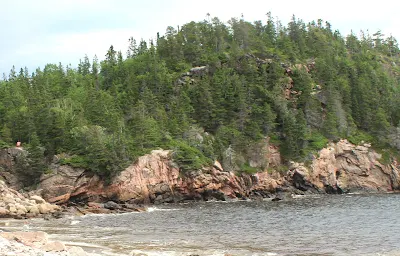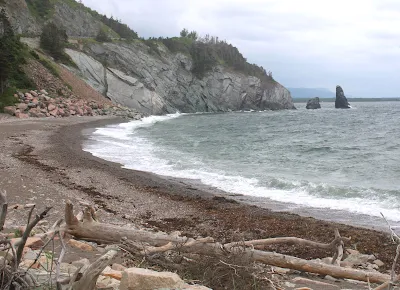 |
| John R Beyer ready to explore the Cabot Trail, Nova Scotia |
It was not always easy to be an early explorer. Take Christopher Columbus for example: in August of 1492, he took off with the ships from modern day Spain and headed for India.
In October of that same year, his tired and ocean-weary band of sailors arrived in what would later be known as the Caribbean.
Columbus, being rather hard-headed, referred to the folks they found paddling around the island in canoes Indians, believing he had ventured all the way across the great waters to South Asia.
A rumor is that one of his sailors pointed out the ‘Indians’ were drinking foo-foo drinks from coconuts with little plastic umbrellas stuck in them, and did not seem like the people they were supposed to meet.
“Are they not supposed to be wearing dupattas, your Excellency?”
“Senza senso,” Columbus may have replied.
Even when the natives started shouting, “It’s gotta be five o’clock somewhere,” the expedition leader continued to tell his men it was nonsense and they had reached India.
“But, let’s not advise Isabella,” he may have said. “She gets sort of touchy now and then.”
And even when the explorer John Cabot left England in 1496 after being given permission by King Henry VII to explore the coast of North America, all did not go as planned.
A letter written by John Day, a Bristol merchant, stated the following of Cabot’s first venture into the unknown: ‘He went with one ship, his crew confused him, he was short of supplies and ran into bad weather, and he decided to turn back.’
Sounds a lot like me when my lovely wife, Laureen, sends me to Target.
“Where’s the bread?” she may inquire.
“I got beer, it’s sort of like liquid bread.”
But Cabot’s second venture turned out a lot better and he landed on the North American coastline on June 24, 1497. The exact location is not truly known, since GPS was a couple of years away, but it is believed the adventurer landed either on Cape Bonavista, near St. John’s in Newfoundland, or on Cape Breton in Nova Scotia.
Since we were in Cape Breton, that is where I chose to believe he made landfall 527 years ago.
Our home for a few days was the small fishing village of Baddeck, which lies upon the gorgeous waters of Bras d’ Or Lake. One thing we learned while traveling Nova Scotia is that most places you'd want to visit are within a few hours’ drive and so, having a home base made a lot of sense.
It also saved my back a lot of pain toting Laureen’s ten suitcases from the rental car to a different hotel room each evening.
The roadway which supposedly shows the route Cabot sailed and trapsied around Cape Breton is 185 miles long - it is a well-paved, winding road that reveals some of the most stunning scenery I have ever witnessed.
 |
| Majestic coastline along the Cabot Trail, Nova Scotia |
Trunk 30 is the main path to follow the Cabot Trail and since I had never heard of a trunk except for the rear of a vehicle where goombas used to stash bodies or rich folks use when traveling on luxury cruises, I was puzzled.
A trunk road in Nova Scotia is used for long-distance and freight traffic. They are the recommended routes between cities, ports, airports, and other places. Of course, since most are single lane each way and possibly narrower than highways, visitors should expect slower times in reaching destinations.
The term is also utilized to perplex out-of-country drivers.
“Should we pack a picnic?” Laureen asked, the morning we were going to venture around the Cabot Trail.
I nodded. “Yes, how about Scotch eggs, apple pie with pickled figs, and black pudding?”
“Nope, just bring your wallet for when I get peckish,” Laureen replied. No homemade picnic basket would be accompanying us that day - that would also mean no pear pies, drat!
Driving around Cape Breton takes a person with nerves of steel and a head on a swivel. There is a constant gorgeous coastline, tracts of green trees, cute little forest creatures darting here and yonder, and houses hugging the shore with docks.
 |
| Forests right down to the ocean's edge, Nova Scotia |
A house with a dock means there is a boat, and I love boats.
That concept was mentioned enough that Laureen finally stopped me, “I know, that house with that dock means our pontoon tied to the cleats there.
“No, that house deserves a fifty-foot Grand Banks,” I replied.
I drove on and at every curve of the road the view never changed, it was all beautiful. Of course, being a Desert Rat, seeing green trees, green bushes, green grass, green moss, and sometimes people green with envy is a wonderful treat.
I wrote about Baddeck in an earlier column but we also drove through tiny towns or villages by the names of St. Anns, North Shore, French River, and Nell’s Harbor while traveling north. Each place was a photo stop - and none were better than the last.
We stopped at a town by the name of Ingonish which boasts one of the top 100 golf courses in the world. Since I had not brought my clubs and was wearing a pair of ankle high Keenes, I did not think I would be allowed to play.
“Puhleez, the servants quarters are in the back,” the golf pro stated at the Cape Breton Highland Links.
Traveling often reveals things a person did not know, of course that is a good enough reason to travel. We discovered that Ingonish has a wonderful winter skiing resort by the name of Cape Smokey. We stopped by to see what this was all about and were pleasantly surprised by what we learned.
It is a four season resort for skiing, hiking, having lunch, or just taking a gondola ride to the top of Cape Smokey to enjoy the views of the Atlantic Ocean and the Cape Breton Highlands National Park.
Unfortunately, we did not have the time to travel up to the 1,000 feet to the top of Cape Smokey on this trip and marveled that folks can ski at such a low elevation.
I asked a staff member at the gift shop.
“It’s cold here in the winter and everything is covered with snow,” she replied.
In winter, Ingonish has an average temperature of 32 degrees fahrenheit during the day and 18 degrees at night. A person could ski on their driveway for most of the winter is my guess.
We took our time touring the Trunk and stopped here and there for photographs or just to enjoy the immense beauty of nature along the Cabot Trail.
 |
| There are hundreds of spots for a walk along the coastline, Nova Scotia |
Around oneish, we both were getting ready for a bit of lunch and found a wonderful little restaurant high on the cliffs overlooking the Atlantic Ocean.
Tables were set outside but since the weather had turned suddenly, such is the way in Nova Scotia, and the wind was now howling and we could see reindeer in the air, we chose the interior which was warm and friendly.
The owner smiled, “You should be here when the wind really blows.” At that moment a Prius was hurled down upon the rocky shores.
“I see,” I replied.
My order was a basket of fried shrimp with scallops and Laureen ordered something - I don’t recall. But my lunch was fabulous with a cold Big Spruce as a chaser.
One of the most picturesque stops was the town of Cheticamp which is heading south toward our temporary home of Baddeck.
 |
| A fishing boat heading out for a late day of fishing |
The name of the town probably comes from the native Mi’kmaq which means ‘rarely full’, indicating the harbor was rarely full of sand which allowed boats to enter unhindered by Mother Nature.
And I enjoyed the name because if you say it multiple times fast enough it sounds rather naughty.
We stopped, even though we had eaten lunch a mere two hours earlier at the DoryMan Pub and Grill because it sat waterside and the sun was shining.
“It is so beautiful here,” said our waitress. “I’ve only lived in town a couple of years but I could not imagine living anywhere else.”
“How about winter?” I asked.
“Wear heavier clothing.”
We wandered the boardwalk, and just enjoyed the brilliance of this now late afternoon summer day on Cape Breton.
On the drive back to Baddeck we passed other towns such as Margaree Harbour, and Lake O’Law and appreciated the stoic folks who founded these towns so many centuries ago, but also the resilient people who still live here battling the brutal winters.
Five hours is recommended for the route and we spent nearly nine. It was not even close to what was needed to take in all that the Cabot Trail and the lovely citizens along its route had to offer.
 |
| Memorial to those service members who would not be returning home |
John can be reached at: beyersbyways@gmail.com

















































